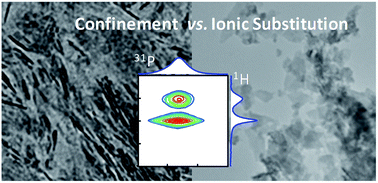Impact of collagen confinement vs. ionic substitutions on the local disorder in bone and biomimetic apatites†
Abstract
The aim of the study is to identify some key physico-chemical parameters that influence the structural characteristics of carbonated hydroxyapatite and, in particular, the so-called “poorly crystallized” nature of bone hydroxyapatite. Here, we investigate this feature by 1D and 2D 1H–31P solid-state NMR experiments through the evaluation of the local order/disorder around the phosphate and the hydroxyl ions in the crystalline apatitic core as well as the quantification of the amorphous layer. The study relies on a large variety of apatite models, i.e. from pure highly crystalline apatites to tissue-like models, as well as on fresh intact bone. We show that both collagen confinement and ionic substitutions have an impact on the structural characteristics of apatite. Nevertheless, while collagen confinement appears predominantly in the initial stages of apatite formation, these characteristics are later dominated by the ionic substitutions, specifically from carbonate ions. We show that an amount of CO32− around 7–8 wt% is necessary to set biomimetic apatite models possessing similar structural characteristics to those found for bone minerals.


 Please wait while we load your content...
Please wait while we load your content...